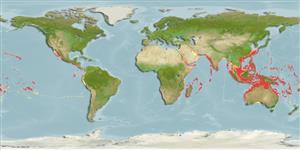Common names from other countries
>
Anguilliformes (Eels and morays) >
Ophichthidae (Snake eels) > Ophichthinae
Etymology: Myrichthys: Greek, myros, -ou = male of morey eel + Greek, ichthys = fish (Ref. 45335).
More on author: Cuvier.
Environment: milieu / climate zone / depth range / distribution range
Ökologie
seewasser riff-verbunden; tiefenbereich 0 - 262 m (Ref. 9710). Tropical; 30°N - 33°S
Indo-Pacific: Red Sea and East Africa to the central Pacific, not including Hawaii and the Leeward Islands. Replaced by Myrichthys magnificus in the Hawaiian Islands (Ref. 26145, 37816).
Size / Gewicht / Alter
Maturity: Lm ? range ? - ? cm
Max length : 100.0 cm TL Männchen/unbestimmt; (Ref. 1602); common length : 50.0 cm TL Männchen/unbestimmt; (Ref. 9137)
Rückenflossenstacheln (insgesamt) : 0; Rückenflossenweichstrahlen (insgesamt) : 0; Afterflossenstacheln: 0; Afterflossenweichstrahlen: 0; Wirbelzahl: 185 - 189. Pale cream in color with variable pattern of large and small black spots with narrower white interspaces (Ref. 3972, 48635). Young with black saddles (Ref. 3972). Its behavior is similar to Myrichthys colubrinus and Leiuranus semicinctus.
Found in sandy areas of reef flats, lagoons, and seaward reefs; living buried in the sand. May aggregate in large numbers under a light at night (Ref. 9710). Sometimes fully exposed when searching for prey (Ref. 30874). Feeds on small fishes and crustaceans (Ref. 89972). Solitary and more common at night (Ref 90102).
Life cycle and mating behavior
Maturities | Fortpflanzung | Spawnings | Egg(s) | Fecundities | Larven
McCosker, J.E. and R.H. Rosenblatt, 1993. A revision of the snake eel genus Myrichthys (Anguilliformes: Ophichthidae) with the description of a new eastern Pacific species. Proc. Calif. Acad. Sci. 48(8):153-169. (Ref. 40867)
IUCN Rote Liste Status (Ref. 130435)
CITES (Ref. 128078)
Not Evaluated
Bedrohung für Menschen
Harmless
Nutzung durch Menschen
Fischereien: kommerziell; Aquarium: Kommerziell
Tools
Zusatzinformationen
Download XML
Internet Quellen
Estimates based on models
Preferred temperature (Ref.
115969): 19.2 - 28.2, mean 26.1 (based on 991 cells).
Phylogenetic diversity index (Ref.
82804): PD
50 = 0.5005 [Uniqueness, from 0.5 = low to 2.0 = high].
Bayesian length-weight: a=0.00089 (0.00039 - 0.00204), b=3.00 (2.80 - 3.20), in cm Total Length, based on LWR estimates for this (Sub)family-body shape (Ref.
93245).
Trophic level (Ref.
69278): 3.6 ±0.5 se; based on size and trophs of closest relatives
Widerstandsfähigkeit (Ref.
120179): mittel, Verdopplung der Population dauert 1,4 - 4,4 Jahre. (Preliminary K or Fecundity.).
Fishing Vulnerability (Ref.
59153): High vulnerability (60 of 100).
